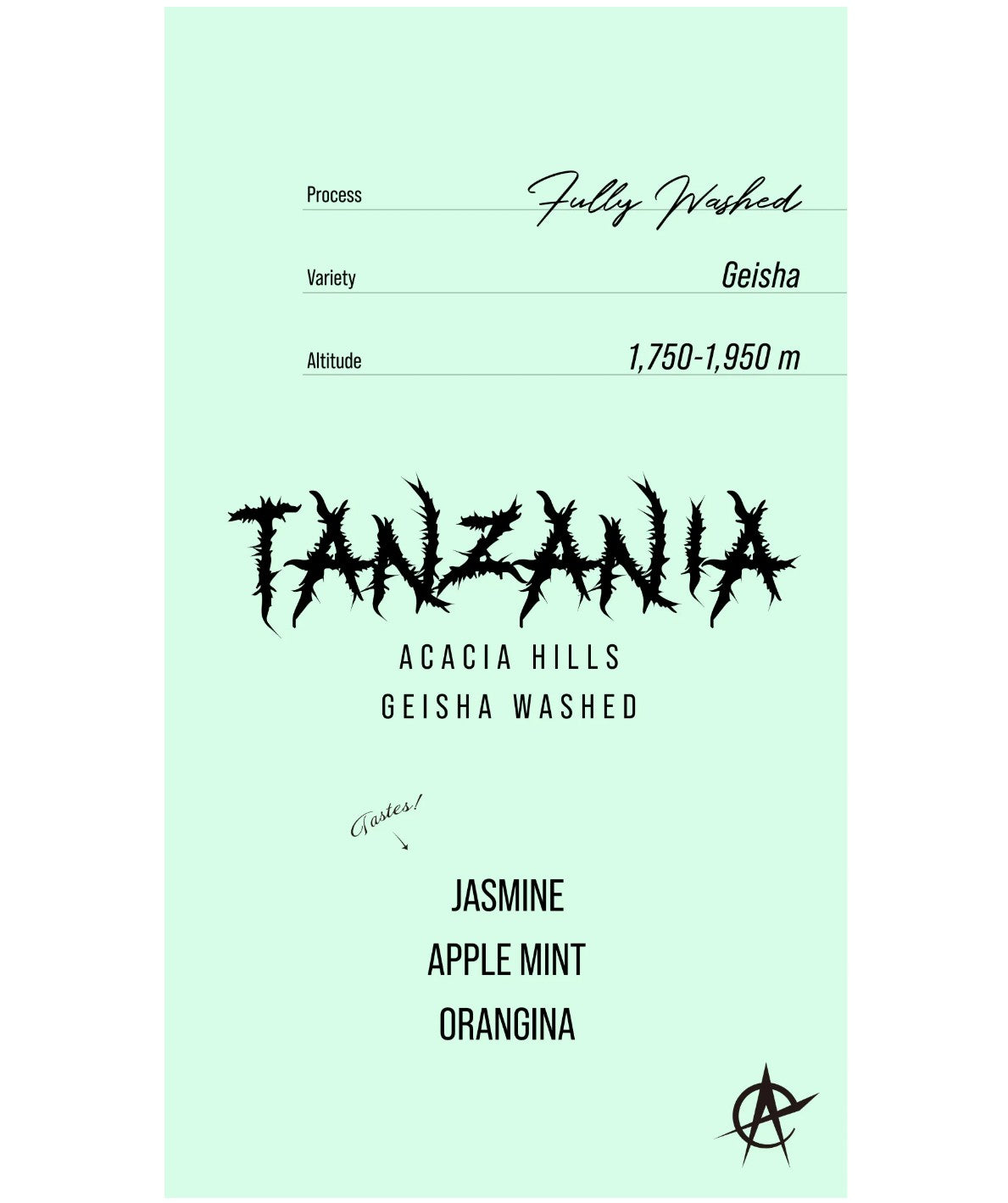stoa coffee
ACID - Tanzania Acacia Hills Geisha Washed - (Tanzania, Fully Washed, Geisha)
ACID - Tanzania Acacia Hills Geisha Washed - (Tanzania, Fully Washed, Geisha)
Couldn't load pickup availability
Tasting Notes: Jasmine, Apple Mint, Orangina
Farm: Acacia Hills
Country: Tanzania
Process: Fully Washed
Variety: Geisha
Altitude: 1750-1950m
[Tanzania Acacia Hills, Geisha - Fully Washed]
A rare Tanzanian Geisha! A juicy and slightly gorgeous Geisha Washed! When it's warm, it has a slight floral scent like jasmine, and is juicy like a red apple! When the temperature drops, it has a refreshing citrus flavor like Orangina and a refreshing taste like cider! There is also a slight herbal nuance like lemongrass. This Tanzanian Geisha has a proper Geisha-like side!
[About Acacia Hills]
Acacia Hills is a farm located at the foot of Mount Oldeani in northeastern Tanzania. Coffee production in Tanzania has a long history, and in northern Tanzania, coffee cultivation has been carried out by German immigrants since the 1920s. However, even today, most of the coffee produced in Tanzania is commodity grade. Several farms, including Acacia Hills, are currently leading the Tanzanian specialty coffee. Coffee cultivation on this farm started when the current owner's grandparents moved here from Greece, and Mr. Leon moved the farm to its current location in Oldeani. Currently, this farm grows a variety of varieties, including Geisha, Pacamara, Kent, and SL28.
[Various Geisha varieties]
Ethiopia's Geisha variety originates from the Gesha variety in Gesha Village. However, Geisha is not a single type of coffee. There are four main types of coffee called "Geisha". ・Geisha beans that traveled to Central America, such as Panama, via Costa Rica are large and have a long face. This is the one that combines the floral flavor and sweetness that is said to be typical of Geisha. ・Malawi Geisha Geisha that traveled to Malawi in 1956. It is a completely different variety from Panama Geisha. The beans are small and round. But it's a little long-faced. Ethiopian-like taste: 1931 Geisha/Gori Geisha 2011. Carefully selected from the native varieties in Geisha Village, (probably) a Geisha close to the source. Not a floral Panama Geisha, but an Ethiopian-like taste. Rust-resistant Geisha. A Geisha that was sent to various countries as a rust-resistant variety. There is so much confusing information that the details are unclear. I think I was able to get a sense that there are many different types of Geisha. It's also fun to drink while wondering what kind of Geisha you are drinking right now! Try drinking a lot and find the differences!
Acacia Hills Geisha Washed, probably the only farm in Tanzania that grows Geisha! It's rare to see Geisha grown in Africa, not just Geisha! [Tanzania Acacia Hills, Geisha - Fully Washed] A rare Tanzanian Geisha! Juicy and slightly gorgeous Geisha Washed! While it's warm, it has a slight floral scent like jasmine, and is juicy like a red apple! As the temperature drops, it has a refreshing citrus flavor like Orangina and a refreshing taste like cider! A slight herbal nuance like lemongrass also wafts through. A Tanzanian Geisha that truly feels like a Geisha!
[About Acacia Hills]
Acacia Hills is a farm located at the foot of Mount Oldeani in northeastern Tanzania. Coffee production in Tanzania has a long history, and in northern Tanzania, coffee cultivation has been carried out by German immigrants since the 1920s. However, even today, most of the coffee produced in Tanzania is commodity grade. Several farms, including Acacia Hills, are currently leading the Tanzanian specialty coffee industry. Coffee cultivation on this farm began when the current owner's grandparents immigrated from Greece, and Mr. Leon moved the farm to its current location in Oldeani. Currently, this farm grows a variety of varieties, including Geisha, Pacamara, Kent, and SL28. [Various Geisha varieties] Ethiopia's Geisha variety originates from the Gesha variety in Gesha Village. However, Geisha is not a single type of coffee. There are four main types of coffee called "Geisha". -Geisha that traveled to Central America, such as Panama, via Costa Rica The beans are large and long-faced. This is the type that combines the floral flavor and sweetness that is said to be typical of Geisha. -Malawi Geisha Geisha that traveled to Malawi in 1956.A completely different variety from Panama Geisha. The beans are small and round. But it's a bit long-faced and tastes like Ethiopia.
・1931 Geisha/Gori Geisha 2011 A Geisha carefully selected from the native varieties in Geisha Village, (probably) quite close to the source. Not the floral taste of Panama Geisha, but an Ethiopian taste.
・Rust-resistant Geisha A Geisha that was sent to various countries as a rust-resistant variety. The details are unclear because the information is too confusing. I think I was able to get a sense that there are many different types of Geisha. It's also fun to drink while thinking about what kind of Geisha you're drinking right now! Try drinking a lot of them and compare them to find the differences!
Acacia Hills Geisha Washed is probably the only farm in Tanzania that grows Geisha!
Share


